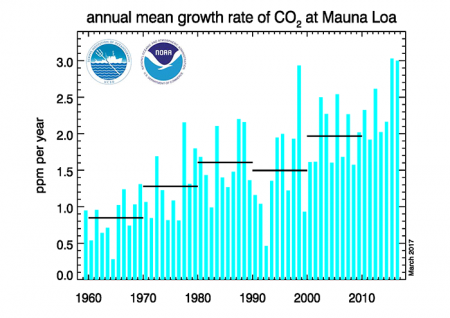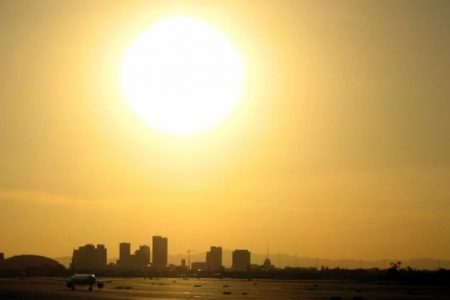April 25, 2017 – When the observatory at Mauna Loa noted the latest readings on carbon dioxide (CO2) last week it was the first time since records on atmospheric composition started being kept that the value exceeded 410 parts per million (ppm). Back in 2013 Mauna Loa informed us we had just surpassed a mean of 400 ppm. So in four years, CO2 increased 2.5%. For climate change skeptics who believe CO2 increases are good, I’m sure they are excited to know that plants will be the beneficiaries of all these atmospheric largesse. But for science and scientists, the trend is ominous.

Think about what a 2.5% increase means over four years. Rounding down that is approximately 0.6% per year and when you calculate that annual growth you produce the following values:
- 417 ppm by 2020
- 430 ppm by 2025
- 443 ppm by 2030
- 456 ppm by 2035
- 470 ppm by 2040
- 484 ppm by 2045
- 499 ppm by 2050
In 37 years at the current rate of CO2 increases, we could see a 90 point increase, that is, if we continue to pay lip service to the carbon problem of our modern industrial model.
It should be of deep concern to all humanity that the paradigm of our existence threatens our existence as we know it.
At 499 ppm the 2 Celsius (3.6 Fahrenheit) degree rise that represents the upper limit of the Paris Climate Agreement becomes unachievable. The science used to calculate that upper limit was based on CO2 peaking at 450 ppm. At 499 we’ll be well over that.
Cold comfort comes from the tracking CO2 output from human activity for the last three years. Statisticians tell us CO2 output numbers have been flat, that current human activity hasn’t increased the amount of carbon being pumped into the air. The stated reason, the closing of coal-fired power plants with conversion to the burning of natural gas, combined with an increase in renewable energy.
Of equal concern is the measuring of other industrial greenhouse gasses being produced. What about methane (CH4) levels? What about nitrous oxides (NOx)? Are we measuring their atmospheric concentrations with the same degree of rigour as CO2? In a paper published in the last week in the Proceedings of the National Academy of Sciences, it notes that since 1850 CH4 in the atmosphere has doubled, and after a period of stability from 2000 to 2007 has been rising again. Since CH4 comes from both natural (cow flatulence and melting permafrost) and industrial sources (oil and natural gas fields) one could theorize that a combination of hydraulic fracturing in the United States and permafrost melt increases could explain the rise since 2007. But the paper further comments that the “current surface observation network” for CH4 is inadequate to the task and measuring the gas requires a level of diligence equal to what is being done with CO2.
As for NOx, an equally potent greenhouse gas, the trend indicates that it too is increasing in emission volume in the 21st century. What is the believed cause? Fossil fuel combustion, application of fertilizers containing nitrogen, and the burning of forests in tropical areas. As in the case of CH4, NOx emission tracking lacks the resources deployed to study CO2.
So we have three potent greenhouse gasses contributing to mean atmospheric temperature increases, with a good handle on one, CO2, and far less on the other two. Should we assume that when we begin to bend the CO2 output curve downward we will also see CH4 and NOx declines? Or do we need to be addressing each of the three differently with individual global strategies?
With President Donald Trump in office, and with Scott Pruitt at the head of the Environmental Protection Agency (EPA), we have chief climate policy influencers from the second largest carbon polluter on the planet paying little attention to what I have described above. The President has defined climate change as a “hoax.” And the head of the EPA, a non-scientist has expressed his opinion that CO2 is not a “primary contributor” to global warming. Don’t ask the President or the new EPA head about CH4 and NOx. Neither will register.
This week the United States government has indicated it will announce whether the country will honour the commitments made in the Paris Climate Agreement. The head of EPA has described the agreement as a “bad deal” for the United States.









